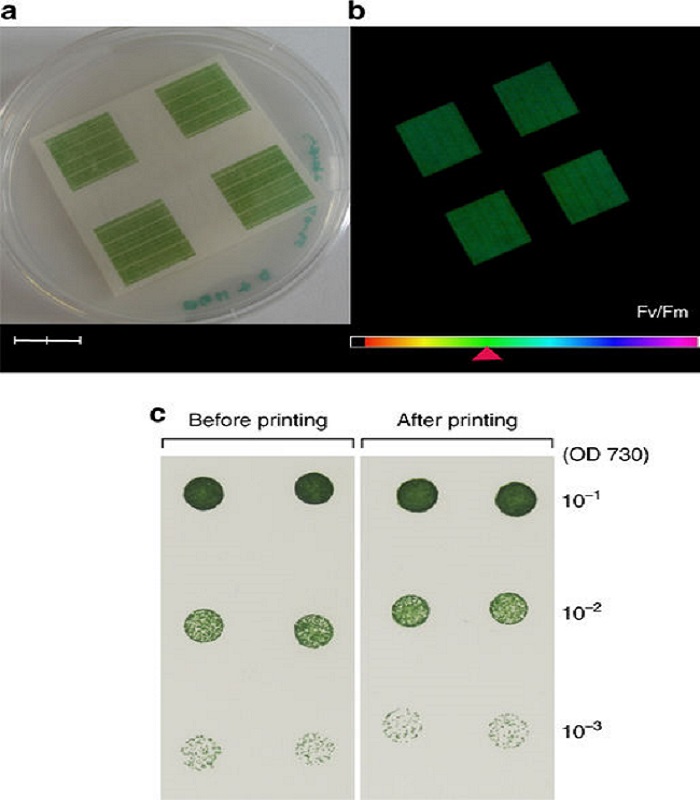These types of bio-electrochemical systems are clearly more advantageous than conventional microbial fuel cells, which require the input of organic carbon for microbial growth.
Scientists from Imperial College London and the University of Cambridge, writing in the journal Nature, demonstrated the feasibility of BPVs using a simple commercial inkjet printer to make a thin-film paper-based BPV cell, with a layer of cyanobacterial cells on top of a carbon nanotube conducting surface.
The researchers show in their experiment the capacity of cyanobacteria to generate sustained electrical current both in the dark as a ‘solar bio-battery’ and in response to light as a ‘bio-solar-panel’, which can potentially find applications in low-power devices that they successfully tested on small LEDs and alarm clocks.
With the main focus having traditionally been on the use of heterotrophic bacteria to convert organic carbon substrates into an electrical output in so-called microbial fuels, more recently, photoautotrophic cyanobacteria and unicellular algae have successfully produced a minimal type of microbial fuel cell called a BPV cell, which can operate successfully in the absence of an added carbon feedstock. What happens instead is that electrons are released in the light during the process of oxygenic photosynthesis and in the dark during the oxidation of carbohydrate or other carbon–containing compounds, synthesized from carbon dioxides.
BPV devices are able to fix light-induced damage to the photosynthesis apparatus, in contrast to semi-artificial PV systems that contain isolated photosynthesis reaction centers, hence making bio-PV devices a more durable option. This would further suggest that BPV can play a role as environmentally friendly power supplies for use in low-power application develop.
The group of researchers have put forward three innovations they believe can lead to the miniaturization of BPV cells, from which large-scale production and application can ensue.
Popular content
They demonstrated firstly the feasibility of using an inexpensive commercial inkjet printer to print a ‘bio-ink’ of cyanobacterial cells on to paper under conditions that allow the cells to remain fully viable and to retain their photosynthetic capacity after printing. This would make BPV very accessible.
Secondly, they showed that inkjet printing can be used to assemble both the non-biological and biological parts of a ‘bio-electrode’, and that this printed bio-electrode produces an electric current at similar levels to the traditional bio-electrode used in BPV devices and is capable of powering a small digital clock or low-power LED light.
Finally, the scientists used inkjet printing to fabricate a ‘thin-film semi-dry’ BPV cell in which a water-absorbent gel was used to replace the cumbersome liquid reservoir. They showed that this type of BPV device is capable of producing sustained current for more than 100 hours.
The cyanobacterial cells came through the printing process unscathed, and were able to grow on the printed electrode to form a solid culture that helps reduce the volume of starting culture, thereby improving water-use efficiency; an important consideration when scaling up the growth of cyanobacteria. Growing a solid layer of cyanobacteria allowed them to replace the liquid reservoir normally used in conventional BPV devices with a gel to form a ‘semi-dry thin-film’ BPV cell, which has potential for miniaturization as well as opening new avenues for large-scale production.
This content is protected by copyright and may not be reused. If you want to cooperate with us and would like to reuse some of our content, please contact: editors@pv-magazine.com.


By submitting this form you agree to pv magazine using your data for the purposes of publishing your comment.
Your personal data will only be disclosed or otherwise transmitted to third parties for the purposes of spam filtering or if this is necessary for technical maintenance of the website. Any other transfer to third parties will not take place unless this is justified on the basis of applicable data protection regulations or if pv magazine is legally obliged to do so.
You may revoke this consent at any time with effect for the future, in which case your personal data will be deleted immediately. Otherwise, your data will be deleted if pv magazine has processed your request or the purpose of data storage is fulfilled.
Further information on data privacy can be found in our Data Protection Policy.